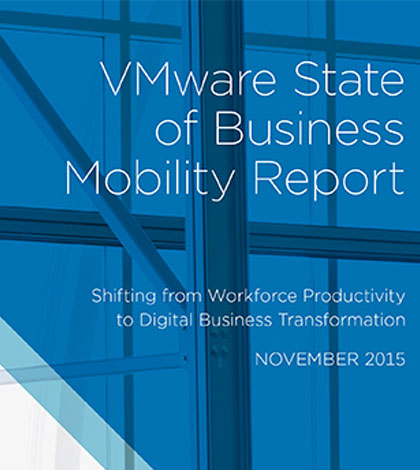TECH NEWS
The Next Phase of Business Transformation Is Here
Mobility is transforming the way the world does business. Many CIOs are prioritizing this transition to the mobile mindset, with the hopes of profoundly enhancing the experience of customers and employees—streamlining processes, encouraging collaboration, and simplifying transactions. But how are businesses across the globe faring in this transformation?
November 19, 2015

Mobility is transforming the way the world does business. Many CIOs are prioritizing this transition to the mobile mindset, with the hopes of profoundly enhancing the experience of customers and employees—streamlining processes, encouraging collaboration, and simplifying transactions. But how are businesses across the globe faring in this transformation?
VMware surveyed 1,182 CIOs, business decision makers, and IT practitioners to examine the transition of companies from the client server era to the mobile cloud era. The results of the business mobility report reveal a tension between how the market wants to be using mobility to drive business results, and how it is using mobility today.
While the majority of the market surveyed has successfully utilized mobility to enhance the productivity of individuals—effectively securing consumer devices, delivering productivity tools to employees, and extending core applications—only a minority have been able to combine mobility and business process transformation efforts, shifting core operations, mission critical applications, and customer-facing services to a mobile style of business. It is this shift, the survey finds, that holds the greatest potential and will make the greatest impact in the market in the coming 12 months.
Those that have successfully achieved this goal of business mobility are reaping the benefits of a more effective workforce and a more competitive place in the market. Across all industries, organizations are changing the retail experience from inventory to point of sale, defining a new style of patient care in the healthcare sector, and streamlining operations for all markets—achievements that far surpass the individual productivity investments that defined the early stage of mobility.

Companies endeavoring to adopt business mobility solutions naturally segment into three stages based on their progress, with a majority currently in an intermediate or early stage of adoption. Companies in the mature stage make up only 20% of the total surveyed, meaning less than a quarter of global businesses have shifted a core business process, like inventory management or mobile patient care or insurance claims processing, to a mobile model. However, with another 66% reporting that they have plans to re-engineer core practices with mobility in mind, the market will soon undergo a significant and strategic shift to mobile.

Companies planning to introduce new mobile practices in the next 6 to 12 months understand that investments cannot be made in isolation. Success for these organizations will only come through a combined investment in new applications for employees and customers, and in enhancements to the infrastructure driving and securing these applications—all wrapped around re-imagined processes that support a new mobile style of work and new ways of engaging with corporate information and customers.
Though a majority of companies can easily envision a mobile future for their business, actually executing on the mobility transformation can be more difficult. Since business mobility initiatives support mission critical initiatives like revenue generation, customer relationships, and business operations, it’s no surprise that organizations cite security and risk of data loss as the top two challenges to achieving business mobility. Increased device heterogeneity continues to add cost and complexity to business mobility initiatives, preventing, or at least slowing, the introduction of new mobile services that can enhance the business.
Although organizations in the midst of the mobile transformation face many challenges, they persist because the benefits are undeniable. Companies that invest in mobility are seeing significant returns—an average of 150% ROI—with an emphasis on business-related ROI, such as the ability to uncover and develop new revenue opportunities. The leading source of ROI is increased end-user efficiency, followed closely by increased security across desktop and mobile.

Mobility leaders are realizing significant operational, cost, and business benefits—including reduced IT staff time, improved overall productivity, increased mobile workforce effectiveness, and the ability to quickly bring new revenue streams online.
Top 5 Takeaways from Implementing Business Mobility
Reaping the ample benefits of a mobile-first strategy requires coordinated planning and execution across IT and lines of business. Survey respondents using VMware solutions cited the following key learnings from their business mobility deployments:
- Invest in user education before implementing new software.
- Balance strategic gains with cost savings.
- Account for time to properly deploy.
- Understand the tight relationship between processes and the software that supports them.
- Establish a business mobility center of excellence to aid the transition.
The shift to the mobile mindset is no longer a thing of the future—it’s already happening. Companies that fail to rethink their strategies risk becoming obsolete. The next phase of the market promises to see an even clearer and more strategic reconfiguration of business around mobile services and touchpoints.
To learn more and discover how VMware can help your business achieve the mobile transformation, read the VMware State of Business Mobility Report